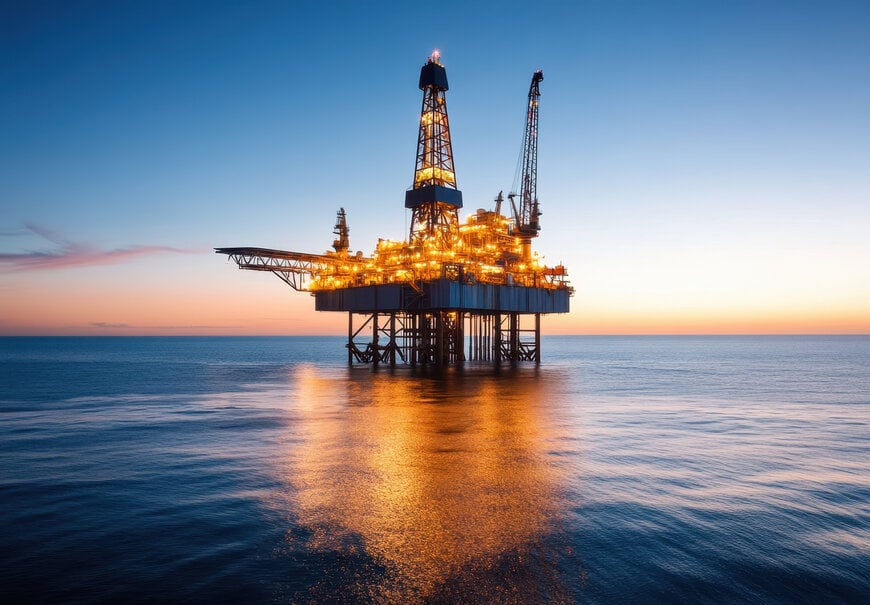Radar Sensors Ensure Precision in Harsh Offshore Conditions
Technidrive highlights VEGA radar technology’s role in improving safety, accuracy, and resilience in extreme oil & gas environments.
www.technidrive.co.uk

Accurate and reliable measurements are essential to some of the world’s most complex and challenging applications. Sectors like offshore drilling, liquified natural gas (LNG) and chemical operations face volatile conditions — including extreme temperatures, corrosive substances and constant mechanical and environmental stresses. Here, David Strain, technical director at specialist supplier of industrial drive systems Technidrive, explains the importance of robust and resilient sensor technologies in these harsh environments.
Offshore drilling remains vital to meeting global energy demands by accessing oil and gas reserves located deep beneath the ocean floor. However, these operations are remote, complex, and hazardous which makes accurate monitoring essential for ensuring operational efficiency — and also safety.
Take the 2010 Deepwater Horizon oil spill in the Gulf of Mexico, for instance, one of the worst environmental disasters in US history. An explosion aboard an offshore drilling platform occurred due to a series of failures including ineffective monitoring, faults in the alarm system and incorrect gas pressure test readings. Overall, this incident can be attributed to poor risk management.
In the years since the Deepwater Horizon incident, regulations around real-time data, well monitoring and testing have tightened to keep offshore operations safe and efficient. To this end, advanced sensor technologies play a vital role in helping operators meet these requirements, and safeguard both people and the environment.
The rise of sensors
Digital sensors are valuable tools that help maintain safety aboard oil rigs. They are a reliable alternative to traditional ultrasonic measurement technologies, and offer faster response times and greater accuracy. Offshore platforms increasingly rely on sensors to perform a wide range of measurements — including level, pressure, interface and density. They are used across critical systems such as mud tanks, oil separators, ballast systems and gas scrubbers.
For example, accurately measuring the levels and interfaces between oil, water and sand is essential for effective separation and maintaining product quality. Advanced sensors also support point level detection, wave and draught monitoring, which helps to ensure operational reliability and safety in hazardous offshore environments.
However, sensors are also vulnerable to the corrosive substances, extreme temperatures and pressure fluctuations aboard offshore platforms and LNG terminals. How is it possible to ensure these sensors remain robust, precise and fail-safe? One answer lies in electromagnetic waves.
Emergency evacuation
Radar sensors use electromagnetic waves that react differently depending on the material they encounter. They are not affected by ambient conditions, which preserves the accuracy and reliability of the measurement. Many sensors offer wireless monitoring and diagnostics from up to 50 metres away, which keeps operators safe when taking measurements.
For example, systems integrator Technidrive supplies sensors from radar technology leader VEGA, with a range of options perfectly suited to offshore applications. These include the VEGAPULS 6X, a highly accurate radar sensor that delivers non-contact level measurements. It can track wave height quickly and precisely, allowing operators to maintain the height of drilling and pumping assets even in the roughest seas.
Let’s consider the example of an emergency lifeboat deployment aboard an oil rig. The VEGAPULS 6X uses a focused 80 GHz beam to deliver precise, non-contact level measurements — even in wind, fog and extreme temperatures — making it ideal for offshore tasks such as measuring wave peaks during the evacuation.
The system also monitors levels in mud tanks, wastewater sumps and gas separators, withstanding pressures up to 160 bar and temperatures as low as –196 degrees Celsius. Complementing this, the VEGAFLEX 86 guided wave radar sensor tracks separation interfaces and fluid levels in oil and gas separators, ensuring product quality and system efficiency under pressures up to 400 bar and across a wide temperature range.
Germany’s Bayernoil refinery — which experienced its own explosion incident in January 2025 — uses VEGAFLEX 86 guided wave radar sensors to improve the separation process in its desalinators. The sensor's precise interface measurements despite fluctuating densities allowed for optimal positioning of high-voltage grids and tank usage. Operating reliably at elevated temperatures around 130 degrees Celsius, the VEGAFLEX 86 ensured accurate monitoring for more efficient processing.
Built to last
To ensure sensors are fail-safe, they must also be made from robust materials. To this end, the VEGAFLEX 86 uses a ceramic cell to monitor mud density in abrasive environments. It is also built from strong materials like 316L stainless steel, Alloy C22 and Tantalum that resist corrosion, seawater and mechanical stress. The sensor’s compact, lightweight design allows for easy installation, and many models, including the VEGABAR 81, are SIL2-certified for reliable and safe use in critical, high-risk applications.
As demands on safety, environmental responsibility and system reliability aboard oil rigs continue to rise, so too does the need for equipment that can perform under pressure. Accurate sensor technologies are proving indispensable here, and the continued evolution of radar and pressure sensing technologies offers a glimpse into a future where offshore monitoring is not only more precise, but also more resilient.
www.technidrive.com

